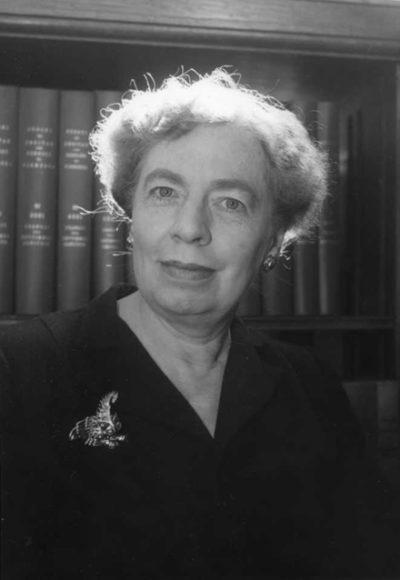Mary Calkins (Mary Whiton Calkins)

Mary Calkins began her serious study of psychology under William James, shortly after his highly renowned textbook, The Principles of Psychology, was printed in 1890. Calkins highly regards one of her first experiences with James in her autobiography, claiming “what I gained from the written page, and even more from tete-a-tete discussion was, it seems to me as I look back upon it, beyond all else, a vivid sense of the concreteness of psychology and of the immediate reality of ‘finite individual minds’ with their ‘thoughts and feelings'”. Although Calkins was very impressed by James’ philosophies and he had initiated her into the field of psychology, James was not an experimentalist, and that was more of Calkins’ area of interest. However, she claims that ultimately it was James’ doctrines of the transitive feelings of relation, the feelings of and, if, and but, and the concept of consciousness as tending to the “personal form,” which could have been what began her major interest in the self. Following her training under James, Mary Calkins worked alongside Edmund Sanford of Clark University, who later assisted her in setting up the first women’s psychology lab at Wellesley College. Sanford trained Calkins on experimental laboratory procedures, as well as helped in the creation and assembly of numerous laboratory instruments for Wellesley’s psychological laboratory.
In 1891, Mary Calkins returned to Wellesley as an instructor of psychology in the philosophy department. After the laboratory was established, it quickly gained popularity; Calkins’ first laboratory seminar yielded over fifty students. Calkins began to make plans for furthering her education in psychology. Advice from Sanford discouraged her from schools like Johns Hopkins and Clark, suggesting they were not likely to admit women as students, much like her experience at Harvard. Sanford did encourage Calkins to explore programs in Europe, making an inference that Hugo Munsterberg admitted female students to his laboratory in Freiburg, Germany (after seeing a picture of Munsterberg in his lab with a woman). After expressing her desire to work with Munsterberg to James, he revealed that Munsterberg would soon be coming to work at Harvard. In the three years that Calkins studied under Munsterberg, several of her papers were published, including research she conducted with Sanford on dreams and her first paper on association. During this time, Mary Calkins also studied memory, leading to her invention of the right associates method, now known as the paired-associations technique. Calkins explains in her autobiography that “by showing series of colors paired with numerals, I found that a numeral which has repeatedly appeared in conjunction with a given color was more likely than either a vividly colored numeral or than the numeral last paired with the color, to be remembered, on a reappearance of the given color”.
In her autobiography she describes Münsterberg as “a man of deep learning, high originality, and astounding versatility.” Other work with Münsterberg included their dream study. Hugo would begin by training her in the detail of laboratory experiments, giving her a research problem based on records that the two of them had taken of their dreams over several weeks. Over those weeks they would wake themselves with alarm clocks at different hours of the night, recorded their dreams, and then studied them intensely. The conclusion they reached was that dreams were nothing more than reproductions of “the persons, places, and events of recent sense perception.” Her study on paired associates learning under Munsterberg constituted her doctoral dissertation that was published in 1896. Harvard refused to approve the recommendation of the Department of Philosophy and Psychology to grant Calkins her doctoral degree. Eliot believed strongly that the two sexes should be educated separately and, although he allowed Mary Calkins to be a “guest,” he and the rest of the board refused to grant her the degree. Calkins had completed all of the requirements for the Ph.D., including passing exams and completing a dissertation, and all of her Harvard professors had recommended her for the degree. Yet, solely due to her sex, she was denied the honor of a conferred degree. James was astonished and described her performance as “the most brilliant examination for the Ph.D. that we have had at Harvard.”
With her supplemental education completed, she returned to Wellesley in 1895 as an associate professor of psychology. Two years after her return she became a professor of psychology and philosophy. This addition allowed her to return to her lectures on the classics and Greek. Her experimental work continued throughout this time. Beginning in 1900, Mary Calkins began to publish a series of papers in which she described psychology as a “science of the self” – this would be a premise to the development of her system of self-psychology. As it can be seen in her writings, although she was very grateful for the individuals who accepted her, she did not hold resentment against those who did not. For instance, instead of expressing disdain towards the Harvard board for not accepting her application for degree, she conveyed her appreciation toward Harvard for allowing her to partake in the courses, conduct research under her professors, and work with individuals such as James, Sanford and Munsterberg. She also mentions the assistance of figures such as Robert MacDougall and several others who spent years with her as her mechanicians, subjects, counselors, and even friends. In addition, when the episode with the waiter refusing her admission took place, she stated in her autobiography that “he correctly insisted against her admission.”
Born
- March, 30, 1863
- USA
- Hartford, Connecticut
Died
- February, 26, 1930
- USA
- Newton, Massachusetts
Cemetery
- Mount Auburn Cemetery
- Cambridge, Massachusetts
- USA



